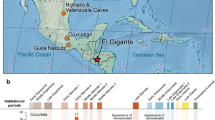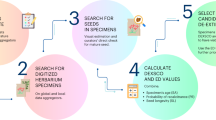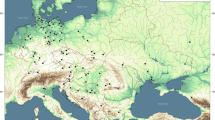Abstract
EVIDENCE for the longevity of seeds is strongest where there is documentary evidence, as with Albizzia julibrissin collected in 1793 and germinated on a herbarium sheet soaked in the British Museum air raid fire of 1940, or the seed of Nelumbium sp. collected in 1705 and then kept in the Harts Sloane collection at the British Museum until 19421. Evidence of age is weaker when it comes from association with archaeological or geological material, for the absolute age of the culture or geological event may be uncertain and the seeds sometimes are not of the same age as the deposit in which they are found. Thus viable seeds of Nelumbium nucifera were recovered from a drained lake at Pulantien, Southern Manchuria, from beneath some feet of loessic silt that were said to indicate an age of many thousands of years2–7, whereas radiocarbon dating of the seeds gave an age not certainly separable from modern, and the alternative view could be held that the silts were recently redistributed by flood8,10.
This is a preview of subscription content, access via your institution
Access options
Subscribe to this journal
Receive 51 print issues and online access
$199.00 per year
only $3.90 per issue
Buy this article
- Purchase on Springer Link
- Instant access to full article PDF
Prices may be subject to local taxes which are calculated during checkout
Similar content being viewed by others
References
Ramsbottom, J., Nature, 149, 658 (1942).
Ogha, I., Bot. Mag. (Tokyo), 37, 87 (1923).
Ogha, I., J. Bot., 64, 154 (1926).
Ogha, I., Jap. J. Bot., 3, 1 (1927).
Ogha, I., Bot. Mag. (Tokyo), 41, 1 (1927).
Chaney, R. W., Bull. Garden Club Amer., May (1951).
Libby, W. F., Radiocarbon Dating (Chicago, 1955).
Godwin, H., and Willis, E. H., New Phytol., 63, 410 (1964).
Godwin, H., and Willis, E. H., Radiocarbon, 6, 132 (1964).
Porsild, A. E., Harington, C. R., and Mulligan, G. A., Science, 158, 113 (1967).
Sivori, E., Nakayana, F., and Cigliani, E., Nature, 219, 5160 (1968).
Willis, E. H., Tanber, H., and Münnich, K. O., Amer. J. Sci. (Radiocarbon Suppl.), 2, 1 (1960).
Author information
Authors and Affiliations
Rights and permissions
About this article
Cite this article
GODWIN, H. Evidence for Longevity of Seeds. Nature 220, 708–709 (1968). https://doi.org/10.1038/220708b0
Received:
Revised:
Issue Date:
DOI: https://doi.org/10.1038/220708b0
This article is cited by
-
Germinating seeds or bulbils in 87 of 113 tested Arctic species indicate potential for ex situ seed bank storage
Polar Biology (2013)
-
Seed viability: Seeds of thought for plant conservationists
Nature (1983)
-
Extreme longevity of lotus seeds from Pulantien
Nature (1982)
-
New Carbon-14 Evidence for Six Hundred Years Old Canna compacta Seed
Nature (1971)
Comments
By submitting a comment you agree to abide by our Terms and Community Guidelines. If you find something abusive or that does not comply with our terms or guidelines please flag it as inappropriate.



